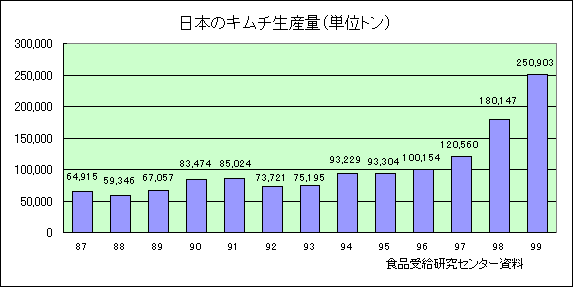Kimchi
キムチ
きむち
Traditional Korean pickles. Made by fermenting Chinese cabbage, giant radish or other vegetables with a mixture mainly of salt, pickled fish, quantities of hot red pepper, garlic, and ginger. Korean households begin their kimchi-making in the autumn when the Chinese cabbage harvest comes in. Kimchi is an essential element of Korean cousine, and there are more than 200 kinds of kimchi classified by their ingredients and the way in which they are pickled. In recent years, kimchi has become a common sight in Japanese supermarkets. Japanese consumption of kimchi is on the increase even as that of traditional Japanese pickles such as takuan pickled white radish and asazuke lightly pickled cucumber and Chinese cabbage is decreasing. According to the Food Marketing Research and Information Center, 250,000 tons of kimchi was consumed in 1999, making kimchi the most popular type of pickle in Japan. Total consumption of all kinds of pickles for the same year was 1.1 million tons. There are two types of kimchi sold in Japan; kimchi imported from South Korea and kimchi made in Japan. In 1999, Japan imported about 21,000 toms of kimchi from South Korea, making it the largest importer of kimchi in the world. The amount of kimchi made in Japan has likewise increased. In 1995, 90,000 tons of kimchi was made in Japan. By 1999, this had jumped to 200,000 tons. Most Japanese-made kimchi is soaked in a kimchi pickling solution in contrast to Korean-made kimchi, which is fermented.

|

yy_d15 |

yy074 |

yy075 |

yy076 |

yy077 |

yy078 |

yy079 |
|